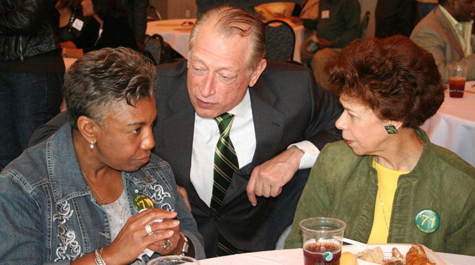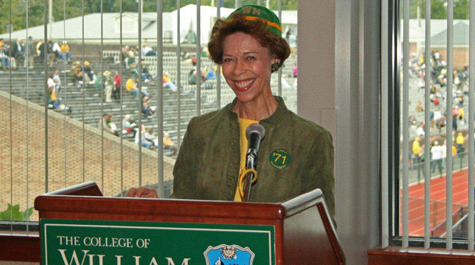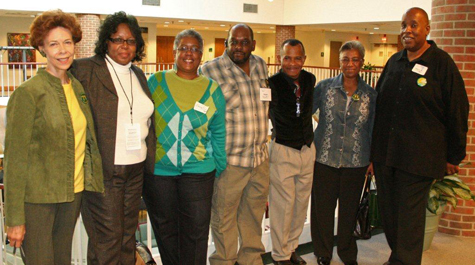W&M's first residential African-American students honored
During Homecoming weekend, over 150 William & Mary faculty, staff, students, alumni and their families joined together to honor the College’s first three African-American residential students: Lynn Briley ’71, Karen Ely ’71, and Janet Brown Strafer ’71.
“When Lynn, Janet, and Karen were at William & Mary, there were only a handful of part-time African-American students enrolled here,” William & Mary President Taylor Reveley said. “But Lynn, Janet, and Karen were very talented. They were self-confident, and they were uncommonly gracious, and they changed forever our campus. We are simply thrilled to have them all back, and have them all back at once for their 40th reunion.”
The event honoring the three alumnae was organized by the Hulon Willis Alumni Association (HWA). During the ceremony, the association presented Briley, Ely, and Strafer with the torch award, which, according to HWA President and Associate Vice President for Development Earl Granger '92, M.Ed. '98, “represents an eternal flame that continues to light the way for all of us.” They were also presented with copies of a plaque made in their honor that will be placed in Jefferson Hall, where they lived for three years.
It is an honor that the three never imagined happening more than 40 years ago when they first arrived on campus. According to Briley, Ely, and Strafer, they weren’t thinking about being the first African-American students to live on campus. They were simply worried about moving in and being away from their parents.
“We felt like any other freshmen,” Ely said.
It wasn’t until orientation that they realized they were the only African-American students living on campus. Even so, they shared many experiences that other students had. They joined the choir and started a student group – the Black Student Organization. They also participated in William & Mary’s traditions, including the wearing of “duc caps” as freshmen.
Strafer sported her original duc cap at the reunion, recalling how freshmen at the time were called “ducs.”
“On the command of upperclassmen, we had to do whatever they said, and we had to quack while we did it,” she said. “We thought it was silly as hell, but we went along with it.”
Now, looking back on her time at the College, Briley said that William & Mary gave her much.
“William & Mary meant a lot to me,” Briley said. “I do remember getting my first job only because they knew I had graduated from William & Mary. I know many of you have had that experience, and it is very prestigious to have the College of William & Mary on your resume.”
Virginia Vogel Carey, '71, M.Ed '79, Ed.S. ’93, Ed.D ‘97, who was a classmate of the three said she couldn’t imagine what their parents must have felt like when they dropped off at the College, not knowing what would happen. Carey later served as dean of admission at William & Mary and was part of the leadership that worked tirelessly to help diversify the College’s undergraduate student population.
Reveley noted how much the campus has changed since the three alumnae graduated 40 years ago. Students of color now make up 27 percent of the student body, he said, and the faculty is becoming increasingly diverse.
“Although the full embrace of diversity came very slowly to William & Mary,” he said, “I believe it has arrived in full force for our student body.”
William & Mary Rector Jeffrey Trammell ’73, who was a William & Mary student during the same time period, said that until the arrival of Briley, Ely and Strafer, William & Mary “didn’t reflect our country. It didn’t reflect who we are.”
Trammell said that the three not only changed the student body, but also the leadership of the College.
“We had in succession: the second woman rector; we had the first African-American rector; we had the first Jewish rector, and the first openly gay rector,” Trammell said. “So, in successive order, this place is starting to look like America because of what you did, and we thank you greatly for that.”
Former Vice President for Student Affairs Sam Sadler ’65 M.Ed. ‘71 worked at the admissions office when they accepted these students. He recalled how Briley, Ely, and Strafer had no support system when they entered the College.
“None of us achieves anything except because other people walked in paths that we have to walk, and passed the way for us,” Sadler said. “Well, let me tell you, folks, these are the women on whose shoulders you stand for what they accomplished or what they did.”
Fanchon Glover, William & Mary’s assistant to the president for diversity and community initiatives, said that institutions such as William & Mary often have celebratory moments like this event that was held for the three alumnae, but then “we just kind of move on and forget that it ever happened.”
“We can’t do that,” she said. “We can’t afford for our children and your children and grandchildren to come here and not know that this place was forever changed when these three women came to William and Mary.”
 Skip to main content
Skip to main content






